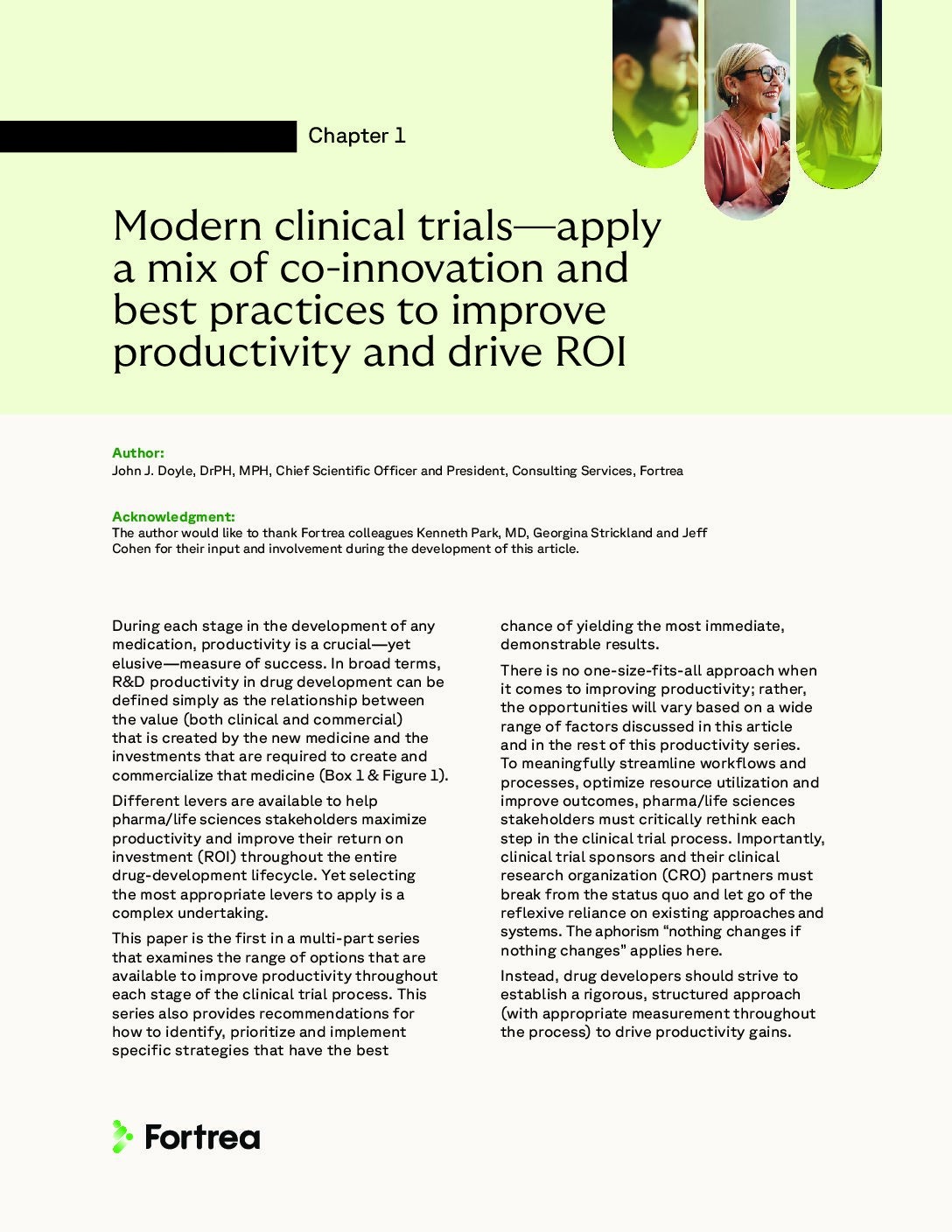
The pharmaceutical industry is facing growing complexity in clinical trials, contributing to longer timelines and ultimately higher costs. These complexities are hindering the industry’s ability to bring new therapies to market quickly and effectively, thus reducing sponsors’ ROI.
Clinical trials saw a 67% increase in the number of procedures in Phase II and III protocols between 2009-2020[i] , and sites are now using more than 20 technology systems daily[ii] – just two indicative metrics that characterize the complexity of today’s landscape.
Trial timelines, and the chances of delay, continue to increase. According to GlobalData’s Clinical Trials database, just 4.5% of clinical trials had a delayed start date in 2003. By 2012, this rose to 15.4% and by 2024 YTD, it had increased again to 21.8%.
The reasons for this increase in delays are varied. Certainly, study recruitment challenges and complex protocols are part of the problem, as are issues with increases in the volume of data collected and trial logistics. However, a perfect storm of increasing regulatory and administrative complexity, growing competition for investigator sites, patient recruitment challenges, and a wide range of inefficiencies are driving costs and timelines up and ROI down, pushing the industry to look hard at areas where productivity can be enhanced.
What do the data show?
Clinical development success rates have been steadily declining. The Likelihood of Approval (LoA) for clinical-stage drugs varies significantly based on trial outcomes, but a well-cited meta-analysis held between 2006–2015 showed that 9.6% of drug development programmes succeeded overall with the result of an FDA-approved drug, calculated by multiplying the phase transition success rates of each individual phase.[iii] Recent data from Biotechnology Innovation Organization show this has now dropped, with overall LoA for all developmental candidates over the 2011–2020 period at 7.9%[iv]. Phase transition data from Citeline for 2014ؘ–2023 show that the average LoA for a new Phase I drug is now just 6.7%.[v]
The good news is the proportion of trials ending prematurely has been decreasing steadily over the past decade, with GlobalData analysis showing the clinical trial termination rate fell from 10.6% in 2010 to 4.7% in 2021.[vi] However, the duration of clinical development has seen a marked increase. According to a Tufts CSDD study, the overall period from IND filing to FDA submission took an average of 89.8 months for drugs approved between 2014–2018, representing an 8.1% increase from 2008–2013.[vii] Phase II trials saw the largest extension, increasing from averages of 27.1 months to 30 months (11%).
Recent analysis from GlobalData suggests the increase in average trial duration seen across all phases during 2010-2019 turned to a modest reduction in average duration in Phases I, III and IV during 2020-2024, while remaining elevated in Phase II.
Longer timeframes drive higher costs. Using GlobalData’s Clinical Trial Cost Estimates model, the average cost of a Phase III trial completed in 2024 was estimated at $36.58 million– 30% higher than the average cost of $28.15 million for one completed in 2018.[viii]
Understanding the causes for increased trial complexity
Firstly, trials are getting more complex and expensive as they target smaller, more specific patient populations and navigate stricter global regulations. This is driving delays in recruitment. Approximately 80% of trials are currently failing to enrol enough patients on time, resulting in study extensions, protocol amendments, or the need for additional study sites.[ix] Additionally, dropout rates are frequently cited as high as 30%[x], often due to complex trial protocols and poor patient experiences, although this may now have dropped to approximately 10% according to the latest patient survey by CISCRP.[xi]
As medical research advances, more intricate and adaptive study designs, extensive data collection requirements and sophisticated analysis plans have emerged. This increased complexity of protocols contributes to higher R&D costs. The amount of data being collected in clinical trials has surged, with a reported 283.2% increase in data points collected during Phase III trials over the last decade.[xii] While data are crucial for understanding drug candidates, excessive data collection complicates trials. Many experts argue that the current data collection practices may be more of a burden than a benefit, complicating the process without necessarily improving outcomes.[xiii]
According to GlobalData’s Clinical Trials database, there were 12,837 company-sponsored clinical trials initiated globally in 2024, representing a 23% increase from the 10,417 studies initiated in 2019. With a high number of clinical trials, there is more competition for investigators, sites and eligible patients, further slowing the recruitment process.
As trials vie for a limited pool of participants, particularly in specialised or rare disease areas, there is increased pressure on ensuring cost-effectiveness and demonstrating value to payers. This can lead to more rigorous trial designs with additional endpoints, contributing to the increased demand for lengthy Phase IV trials focused on studying a therapy’s real-world benefits and risks.
Can innovation improve productivity?
Adapting to the increasing complexity of clinical trials requires continued innovation and productivity improvements. Sponsors must examine each step in the drug development and clinical trial process to optimise resources and streamline workflows.
A rigorous methodology is needed to drive productivity gains, identifying, assessing and prioritising potential opportunities while also managing the implementation of selected initiatives over time. By deploying a mix of strategies, including greater use of advanced modelling and data analytics technologies based on artificial intelligence and machine learning, coupled with operational expertise, sponsors can use data-driven insights to continuously refine their selected initiatives.
With 30 years of experience, Fortrea is a leading global CRO in the biopharma industry, focusing on enhancing productivity in clinical trials and reducing delays. The challenges of recruiting suitable patients for trials also requires a customised solution. This is where Fortrea’s clinical and operational experience and knowledge, use of data and analytics, and strong relationships with sites and patient groups, as well as effective communication, flexibility and resourcefulness come to the fore.
A biopharmaceutical company recently engaged Fortrea to conduct a global Phase III clinical trial on a promising treatment for a rare genetic cardiovascular disease. The sponsor’s tight schedule included a requirement to enrol the first patient within six months of the award announcement. An added complication involved a rival molecule in a similar study had already engaged premier sites.
Using its expertise in cardiovascular clinical trial performance, access to data and insights on site performance, patient pathways and regulatory timeframes, plus an extensive site network and rapid site start-up, Fortrea proactively began identifying and contacting appropriate sites and developing trial infrastructure before a protocol was even available. This first tight deadline not only required rapid site start-up in various geographic regions, but also an understanding of the disease epidemiology and patient demographics.
The US and UK were identified as most likely to have the appropriate facilities, patients and potential for rapid regulatory turnaround and study start-up. In the UK a Phase I unit operating at a private hospital was also identified as a suitable facility. Fortrea trained the Phase I site in the protocol’s requirements, including a unique form of fat biopsy, with advanced cardiac imaging set up at a second cooperating academic site.
Exceptional teamwork, flexibility, innovation and a relentless effort to make things work resulted in meeting the deadline for enrolling the first patient two weeks ahead of time, thereby exceeding expectations for the sponsor.
Conclusion
Clinical trials are complex ecosystems with interconnected players. By working together, the right CRO can bring a deep bench of experience and expertise in clinical trial strategy, design and execution, advanced modelling and data analytics technologies, and use of regulatory-grade real-world data and real-world evidence, to partner with sponsors on process redesign, strategic use of technology advances, and use of modelling, simulation and analytics best practices. Strategic productivity improvements at each step deliver measurable results for clinical and business outcomes, and stronger ROI for drug developers.
Only by leveraging advances alongside flexibility and innovative thinking will sponsors be able to get new therapies to market at greater speed, thus increasing ROI and providing patients with the treatments they need.
For more information on how to apply innovation and best practices to improve clinical trial productivity, download the free paper below.
[i] Getz, Smith, Kravet. Protocol Design and Performance Benchmarks by Phase and by Oncology and Rare Disease Subgroups. Ther Innov Regul Sci. 2022 Aug 12; 57(1):49-56
[ii] https://myscrs.org/resources/sites-now/closing-the-gap-on-clinical-tech-for-sites/
[iii] Mullard, A. Parsing clinical success rates. Nat Rev Drug Discov 15, 447 (2016). https://doi.org/10.1038/nrd.2016.136
[iv] https://go.bio.org/rs/490-EHZ-999/images/ClinicalDevelopmentSuccessRates2011_2020.pdf?_gl=1*wq96ds*_gcl_au*MTU2NTk3OTk3LjE3MzM4NDUwMjA.&_ga=2.17362109.525898288.1737133584-1914066691.1733845020
[v] https://insights.citeline.com/IV154612/Why-Are-Clinical-Development-Success-Rates-Falling/
[vi] https://www.clinicaltrialsarena.com/features/clinical-trial-terminations/
[vii] https://www.appliedclinicaltrialsonline.com/view/applying-pre-pandemic-benchmarks-to-assess-future-speed-strategies
[viii] GlobalData’s Clinical Trial Cost Estimates offers users model based estimates of clinical trial costs by considering factors such as trial-specific attributes in comparison to industry benchmarks, trial complexity, geography, and inflation, etc.
[ix] Desai M. Recruitment and retention of participants in clinical studies: Critical issues and challenges. Perspect Clin Res. 2020 Apr-Jun;11(2):51-53. doi: 10.4103/picr.PICR_6_20. Epub 2020 May 6. PMID: 32670827; PMCID: PMC7342339. https://pmc.ncbi.nlm.nih.gov/articles/PMC7342339/#ref2
[x] Alexander W. The uphill path to successful clinical trials: keeping patients enrolled. P T. 2013 Apr;38(4):225-7. PMID: 23785228; PMCID: PMC3684189. https://pmc.ncbi.nlm.nih.gov/articles/PMC3684189/
[xi] Center for Information and Study on Clinical Research Participation. 2023 Perceptions and Insights Study. https://www.ciscrp.org/wp-content/uploads/2023/11/2023PI_Participation-Experiences.pdf
[xii] https://www.clinicaltrialsarena.com/features/data-management-too-much-blessing-burden/
[xiii] https://www.clinicaltrialsarena.com/features/internet-of-things-a-tsunami-of-clinical-trial-data/



